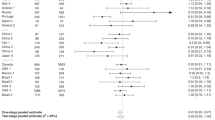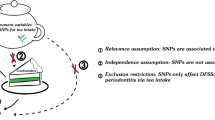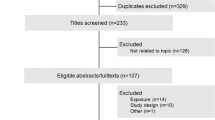Abstract
Background/Objectives:
Epidemiological results on the association between tea consumption and oral cancer remain controversial. We aimed to evaluate the exact relationship between tea consumption and oral cancer in Chinese population.
Subjects/Methods:
A large-scale case–control study was conducted on 586 oral cancer patients and 1024 controls frequency-matched by age and gender. Epidemiological data were collected through face-to-face interviews with a structure questionnaire. Unconditional logistic regression model was used to assess the effect of tea consumption on oral cancer stratified by smoking, alcohol drinking and demographics. Quantity of tea consumed (ml/day) was categorized into five subgroups based on quartiles and then its interactions was evaluated with tobacco smoking and alcohol drinking at each subgroup.
Results:
Tea consumption showed an inverse association with oral cancer for non-smokers or non-alcohol drinkers (the odds ratios (ORs) were 0.610 (95% confidence interval (CI): 0.425–0.876) and 0.686 (95% CI: 0.503–0.934), respectively). For smokers or alcohol drinkers, decreased risk was only observed in those who consumed >800 ml/day. Furthermore, oolong tea consumption was associated with decreased risk of oral cancer in smokers or alcohol drinkers but not in non-smokers or non-alcohol drinkers. Tea consumption combined with smoking or/and alcohol drinking had a greater risk than tea consumption alone, but the risk was roughly reduced from zero to Q4 (>800 ml/day). Additionally, when stratified by demographics, the protective effect of tea was especially evident in females, urban residents, normal body mass index population (18.5–23.9), farmers, office workers and those aged <60 years.
Conclusions:
Tea consumption protects against oral cancer in non-smokers or non-alcohol drinkers, but this effect may be obscured in smokers or alcohol drinkers. Additionally, demographics may modify the association between tea consumption and oral cancer.
This is a preview of subscription content, access via your institution
Access options
Subscribe to this journal
Receive 12 print issues and online access
$259.00 per year
only $21.58 per issue
Buy this article
- Purchase on Springer Link
- Instant access to full article PDF
Prices may be subject to local taxes which are calculated during checkout


Similar content being viewed by others
References
Ferlay J, Soerjomataram I, Dikshit R, Eser S, Mathers C, Rebelo M et al. Cancer incidence and mortality worldwide: sources, methods and major patterns in GLOBOCAN 2012. Int J Cancer 2015; 136: E359–E386.
Zhang SK, Zheng R, Chen Q, Zhang S, Sun X, Chen W . Oral cancer incidence and mortality in China, 2011. Chin J Cancer Res 2015; 27: 44–51.
Ying MG. Malignant Tumor Report of Fujian Province in 2015, 1st edn. Fujian Science & Technology Publishing House: Fujian, China, 2015.
van Dijk BA, Brands MT, Geurts SM, Merkx MA, Roodenburg JL . Trends in oral cavity cancer incidence, mortality, survival and treatment in The Netherlands. Int J Cancer 2016; 139: 574–583.
Franceschi S, Barra S, La Vecchia C, Bidoli E, Negri E, Talamini R . Risk factors for cancer of the tongue and the mouth. A case-control study from northern Italy. Cancer 1992; 70: 2227–2233.
Toporcov TN, Antunes JL, Tavares MR . Fat food habitual intake and risk of oral cancer. Oral Oncol 2004; 40: 925–931.
Radoi L, Paget-Bailly S, Menvielle G, Cyr D, Schmaus A, Carton M et al. Tea and coffee consumption and risk of oral cavity cancer: results of a large population-based case-control study, the ICARE study. Cancer Epidemiol 2013; 37: 284–289.
Fu JY, Gao J, Zhang ZY, Zheng JW, Luo JF, Zhong LP et al. Tea consumption and the risk of oral cancer incidence: a case-control study from China. Oral Oncol 2013; 49: 918–922.
Chen F, He B, Huang J, Liu F, Yan L, Hu Z et al. Effect of tea on oral cancer in nonsmokers and nondrinkers: a case-control study. Chin J Prev Med 2015; 49: 683–687.
Hildebrand JS, Patel AV, McCullough ML, Gaudet MM, Chen AY, Hayes RB et al. Coffee, tea, and fatal oral/pharyngeal cancer in a large prospective US cohort. Am J Epidemiol 2013; 177: 50–58.
Ren JS, Freedman ND, Kamangar F, Dawsey SM, Hollenbeck AR, Schatzkin A et al. Tea, coffee, carbonated soft drinks and upper gastrointestinal tract cancer risk in a large United States prospective cohort study. Eur J Cancer 2010; 46: 1873–1881.
Ide R, Fujino Y, Hoshiyama Y, Mizoue T, Kubo T, Pham TM et al. A prospective study of green tea consumption and oral cancer incidence in Japan. Ann Epidemiol 2007; 17: 821–826.
Tavani A, Bertuzzi M, Talamini R, Gallus S, Parpinel M, Franceschi S et al. Coffee and tea intake and risk of oral, pharyngeal and esophageal cancer. Oral Oncol 2003; 39: 695–700.
Bundgaard T, Wildt J, Frydenberg M, Elbrond O, Nielsen JE . Case-control study of squamous cell cancer of the oral cavity in Denmark. Cancer Causes Control 1995; 6: 57–67.
Radoi L, Paget-Bailly S, Cyr D, Papadopoulos A, Guida F, Schmaus A et al. Tobacco smoking, alcohol drinking and risk of oral cavity cancer by subsite: results of a French population-based case-control study, the ICARE study. Eur J Cancer Prev 2013; 22: 268–276.
Madani AH, Dikshit M, Bhaduri D, Aghamolaei T, Moosavy SH, Azarpaykan A . Interaction of alcohol use and specific types of smoking on the development of oral cancer. Int J High Risk Behav Addict 2014; 3: e12120.
Kleihues P, Sobin LH . World Health Organization classification of tumors. Cancer 2000; 88: 2887.
Fujiki H, Sueoka E, Watanabe T, Suganuma M . Primary cancer prevention by green tea, and tertiary cancer prevention by the combination of green tea catechins and anticancer compounds. J Cancer Prev 2015; 20: 1–4.
Shukla Y . Tea and cancer chemoprevention: a comprehensive review. Asian Pac J Cancer Prev 2007; 8: 155–166.
Hibasami H, Jin ZX, Hasegawa M, Urakawa K, Nakagawa M, Ishii Y et al. Oolong tea polyphenol extract induces apoptosis in human stomach cancer cells. Anticancer Res 2000; 20: 4403–4406.
Pan MH, Liang YC, Lin-Shiau SY, Zhu NQ, Ho CT, Lin JK . Induction of apoptosis by the oolong tea polyphenol theasinensin A through cytochrome c release and activation of caspase-9 and caspase-3 in human U937 cells. J Agric Food Chem 2000; 48: 6337–6346.
Jacob P 3rd, Abu Raddaha AH, Dempsey D, Havel C, Peng M, Yu L et al. Comparison of nicotine and carcinogen exposure with water pipe and cigarette smoking. Cancer Epidemiol Biomarkers Prev 2013; 22: 765–772.
Hecht SS . Cigarette smoking: cancer risks, carcinogens, and mechanisms. Langenbecks Arch Surg 2006; 391: 603–613.
Purohit V, Khalsa J, Serrano J . Mechanisms of alcohol-associated cancers: introduction and summary of the symposium. Alcohol 2005; 35: 155–160.
Luciano M, Kirk KM, Heath AC, Martin NG . The genetics of tea and coffee drinking and preference for source of caffeine in a large community sample of Australian twins. Addiction 2005; 100: 1510–1517.
Song WO, Chun OK . Tea is the major source of flavan-3-ol and flavonol in the U.S. diet. J Nutr 2008; 138: 1543s–1547s.
Grosso G, Stepaniak U, Micek A, Topor-Madry R, Pikhart H, Szafraniec K et al. Association of daily coffee and tea consumption and metabolic syndrome: results from the Polish arm of the HAPIEE study. Eur J Nutr 2015; 54: 1129–1137.
Acknowledgements
This work was supported by grants from the Natural Science Foundation of Fujian Province (No.2015J01304), University Development Foundation of National Financial Support (No.1003-03900130). We are deeply grateful to the First Affiliated Hospital of Fujian Medical University for data collection.
Author information
Authors and Affiliations
Corresponding authors
Ethics declarations
Competing interests
The authors declare no conflict of interest.
Rights and permissions
About this article
Cite this article
Chen, F., He, BC., Yan, LJ. et al. Tea consumption and its interactions with tobacco smoking and alcohol drinking on oral cancer in southeast China. Eur J Clin Nutr 71, 481–485 (2017). https://doi.org/10.1038/ejcn.2016.208
Received:
Revised:
Accepted:
Published:
Issue Date:
DOI: https://doi.org/10.1038/ejcn.2016.208
This article is cited by
-
Processing Technologies for the Extraction of Value-Added Bioactive Compounds from Tea
Food Engineering Reviews (2023)
-
A composite oral hygiene score and the risk of oral cancer and its subtypes: a large-scale propensity score-based study
Clinical Oral Investigations (2022)
-
FERMT1 knockdown inhibits oral squamous cell carcinoma cell epithelial-mesenchymal transition by inactivating the PI3K/AKT signaling pathway
BMC Oral Health (2021)
-
Drinking tea before menopause is associated with higher bone mineral density in postmenopausal women
European Journal of Clinical Nutrition (2021)
-
Association between dietary inflammatory index and the risk of oral cancer in the southeast of China
European Journal of Clinical Nutrition (2020)



